When you really think about it, every interaction you have with your audience is an opening for dialogue.
You’re publishing content that’s empowering your audience with knowledge. They’re finding you in different and unique ways, like SEO, social media, and word of mouth.
And guess what. It’s very likely that they want to know more.
They want to have a conversation, and in all industries, conversations play a big role in marketing strategies.
This is where conversational marketing comes in.
What Is Conversational Marketing?
To put it simply, it’s a strategy that gives you the opportunity to engage with your audience on an individual level.
You can start a dialogue across any of the channels your audience, and customers, want to talk.
One of the more popular methods currently is live chat, but there are plenty of other ways to interact, including phone calls, email, replies on social media, and more.
The Basics of Conversational Marketing
Before you start developing your strategy, there are a few foundations you should understand first.
Conversations Are Contextual.
Conversations require context and should evolve as you learn more information. This is an expected experience for clients and customers.
People assume that when they follow up with a business whatever was said in past calls will carry over into the next. It’s a matter of convenience.
Without context, every time a support representative or bot interacts with a person, they’ll have to ask the same, general questions again and again.
This is a waste of time for both sides of business that runs the risk of frustrating the customer.
Look at it from your perspective. As a customer, you want answers quickly and efficiently, but you also want them to be relevant.
It may be a bit of effort to gather, store, and track all of the info you may gather, but that can be aided by making a CRM part of your conversational marketing strategy.
You’ll provide the most value to your customers when you keep up with the context of your conversations with them.
Conversations Happen Where Customers Want Them To.
One of the largest benefits of new messaging technology and tools is that people can communicate in a variety of ways.
Whether it be over the phone, on a computer, with a person, or with a bot, conversations are held wherever works best for the customer.
It’s viewed as a much faster avenue to having a problem solved than calling through the chain of command of a company.
Conversations Happen When Customers Prefer.
With accessibility sitting at a new high, it only makes sense that the time when people reach out will become more fluid as well.
Conversations should happen whenever the customer needs it to. Real-time messaging is an engaging feature, but in reality, most people are going to communicate whenever it’s most convenient for them.
So whether that’s first thing in the morning, before the coffee has even finished brewing, or late at night when the kids are asleep, it’s important for them to be able to reach out at their own pace.
Conversations Are Scalable.
With all of these customer-centric factors in place, conversations need to be scalable. Depending on the volume of calls and messages you get in a day, it can be easy to fall behind.
Chatbots are a great solution to this problem. They never sleep and are, technically, a sort of limitless tool of manpower.
Bots provide 24/7 support that can help take on the more common questions and issues a customer may have.
And even if the conversation becomes a bit more complex than the bot can handle, there’s an easy pass off to a human that will have reference to the entire conversation beforehand. Scale should never get in the way of helping each, individual customer.
Conversations Build a More Human Experience.
How often do you go to a website and feel overwhelmed or lost?
Conversational marketing can help eliminate that experience by making the buyer’s journey feel less alone. Strike up conversations with the people who visit your site so that they know you’re there for them if they should need anything.
Conversational Marketing Statistics Worth Knowing
Drift is one of the leading conversational marketing platforms today.
Their 2019 report found many interesting insights on what customers want and how they behave with businesses.
Customers Want Responses Fast.
This feels like a no-brainer and shouldn't be too surprising, given the fast pace we can all connect and communicate. But what is worth noting is the channels that customers expect timely responses from.
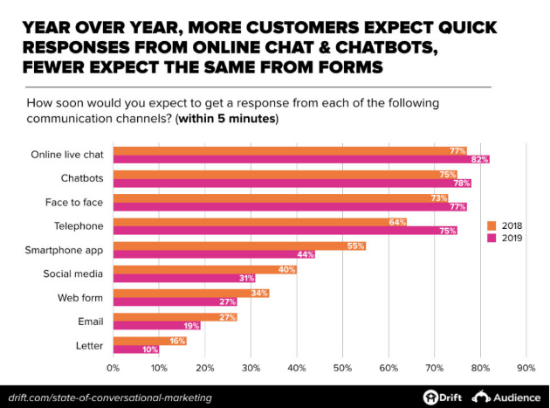
Source: Drift
As you can see live chat, chatbots, and face to face interactions are the top channels where people expect a response within five minutes.
In fact, the expectation for chatbot response time is nearly the same as if they were talking to you in real time.
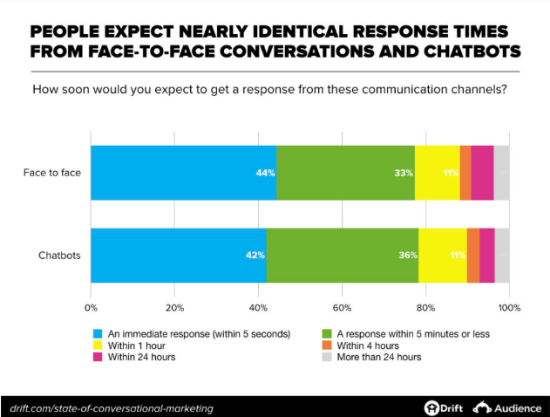
Source: Drift
These expectations may seem daunting, but thanks to technology and all the amazing automation tools available, it's actually possible. And seeing the data, it's becoming a necessity.
Chatbots Are Being Embraced.
Forms still have a place in your marketing strategy, but they're becoming less of a preference in the current marketing landscape.
A whopping 86 percent of Drift survey respondents said they prefer chatbots over forms.
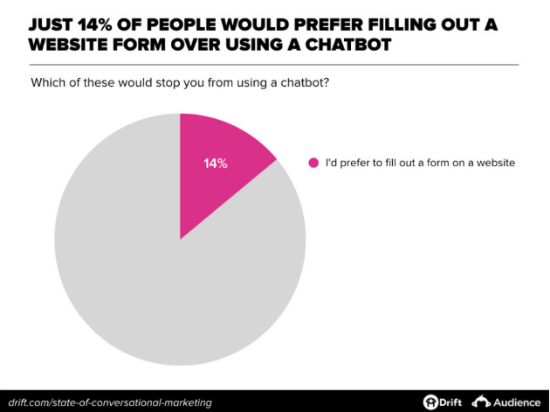
Source: Drift
Again, this doesn't mean it's time to toss your form builder in the trash.
But it does mean you should start building a conversational marketing strategy that gets chatbots in the right places on your site.
Chatbots Are Now Seen As a Channel For Answers.
Most visitors on your site are going to have questions about something. It may be related to your products or services or your pricing.
Or it might be a follow up question about a piece of thought leadership content you published.
No matter the question, visitors want answers. And they embrace chatbots as the right channel for getting information they need.
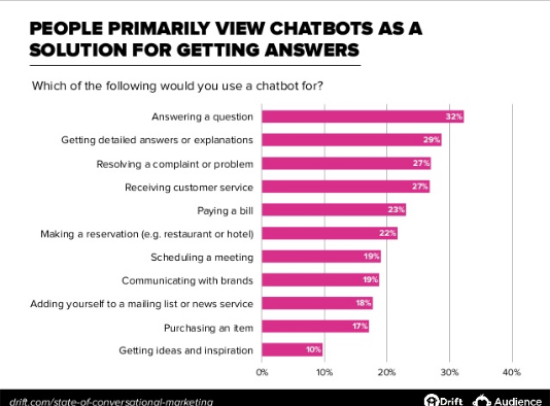
Source: Drift
People also want more functionality out of chatbots, like getting customer service (27 percent) or even scheduling a meeting (19 percent).
As you roll out chatbots, it's important to consider exactly what user experience you want to build and how you can best serve visitors on your site.
Finding Information Efficiently Is Still a Struggle.
Despite all that content on your site, visitors are going to get frustrated by not finding what they need.
These friction points for your visitors can really sour their perception of you and your company as a whole.
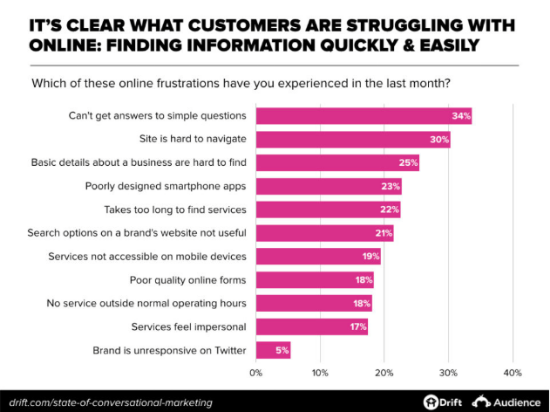
Source: Drift
But the numbers show that folks are open to chatbots as a resource. In fact, they prefer it over more traditional means.
All of that data backs the idea that conversational marketing is a strategy that can evolve with the needs and behaviors of your audience.
But how exactly does it all work?
The Conversational Marketing Framework
It’s a pretty simple framework to familiarize yourself with actually because it includes just three simple steps.
- Engage
- Understand
- Recommend
That’s it!
Let's dive into each step so you know exactly what you want to accomplish in your conversations.
1. Engage With Chat and Bots, Not Just Forms.
Bots are a great means to instantly spark conversations with customers on your website instead of waiting for them to decide if they do or don’t want to fill out a form.
Chats provide a more personal experience with the customer, which translates to better conversion rates and more sales opportunities. They’re a means of moving people through your funnel seamlessly from one stage to the next.
Imagine it in a more physical space. If your website was a huge warehouse, the customer would have a much easier and pleasant experience if they had someone to walk with them from the front door all the way to checkout.
One of the biggest frustrations for IKEA is having to navigate through the enormous building without anyone there to point you in the right direction.
No offense to IKEA, but you shouldn’t want that to be a potential lead’s takeaway for your business when they leave your website, regardless of if they made a purchase or not.
2. Understand, Then Qualify Leads In No Time.
Usually, qualifying leads takes up an incredible amount of time and resources through marketing automation and lead nurturing emails. During that time, there are customers seeking answers and attention.
Bots can address those leads at any point in the day as quickly as a person messages one.
Chatbots now have the ability to qualify leads for you via follow up questions within the chat that you can preset. They’ll have the conversation for you, saving you time, and put the customer on the right path to resolving their need.
While bots disqualify the visitors who aren’t in the right stage of their journey for you, your business is able to speed up its response time and engagement quality.
3. Make Recommendations Based on What You Know.
With bots being as intelligent as they are, they can guide leads to the appropriate sales teams so that your sales representatives can focus solely on selling.
You take a step out of the prospecting stage when a chatbot sets up a meeting for you with a customer automatically on connected calendars.
Not only can they lead people to reps, but they can lead them to content as well. Whatever it is that the lead is seeking or asking for, bots should be able to direct them to a contextual solution on the lead’s timeline.
This simple three step framework fits well into the inbound methodology.
The Inbound Approach to Conversational Marketing
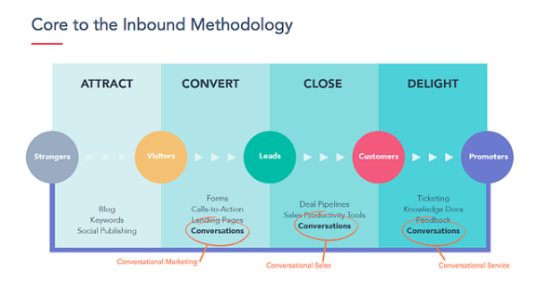
Source: HubSpot
As you can see, there are many areas within the inbound methodology where you can use conversational marketing tactics to guide your audience through the next stages of their journey.
Some tactics include:
Include Chat On Your Contact Us Page Instead of a Form.
Most of your customers probably view the form on your Contact Us page as an ineffective means of getting your attention.
Rejuvenate the landing page by adding a messaging tool. Changing from a form to a conversation can make prospects turn into more qualified prospects since they can get the information they want faster.
You’ll interact with them when they’re in their buying stage, increasing your sales opportunities.
Build Chatbot Playbooks.
Since your chatbots will essentially be the first point of contact to your audience, make sure that you have preset questions, answers, greetings, and other automated responses ready to go 24/7.
Oddly enough, these automatic replies make the entire process feel more human since prospects are getting real-time answers easily.
When you’re off the clock, chatbots are able to keep playing the field so that you come back to a calendar full of booked calls and meetings.
Add Live Chat and Chatbots to High Intent Pages.
Some pages are more valuable than others, like pricing pages for example.
Do some quick research to find out which pages on your website provide the highest impact on conversion, and implement a live chat or bots on those ones only.
Live chat across your website can be annoying for the customer and can confuse your own data with irrelevant chatter that won’t lead to sales.
High intent pages are usually the ones that produce the most questions and have visitors closer to the buying stage, so give them an opportunity to start a conversation with a chat feature.
Conversational Marketing Best Practices
These ideas should guide you on how to start and manage your conversational marketing strategy.
Plan Around the Customer Journey.
Make sure you keep the buyer’s journey in mind when you're building out your strategy. In fact, if you don't have one already, you should develop customer journey maps.
These maps help you visualize the whole customer experience at each stage of their process. You can see where leads enter your marketing and sales cycle.
By looking at each potential touchpoint, you can identify great opportunities to start conversations. Ultimately, this map will help keep you focused on guiding leads to that final sale.
Maintain a Human Element.
via GIPHY
No one wants to chat with robots all of the time, so have some personable interaction along the way.
Keep it conversational in each message so visitors can feel connected to the human side of your business. Make jokes. Use emojis. Have fun.
Remember, this is conversational marketing. You're engaging one on one with a real person. So keep it human.
Simplify Everything (and Keep It Simple).
People want a fast and easy experience. Don’t over complicate the process or drag it out unnecessarily.
And be clear on your objectives for each conversational marketing tactic. You don't want to bombard visitors with long forms on top of the funnel content.
Be strategic so visitors don't feel like they're being interrogated for contact information. Be helpful in the most concise, simple way.
Focus on Key Areas of Opportunity.
When you start building your conversational marketing strategy, tune into the hot spots of your business. That’s where you’ll want to implement your plan.
There are plenty of analytics reports and tools you can use to help determine where you should start executing your conversational marketing strategy.
With the right data, you can really hit the ground running with quick easy wins on high intent pages.
For example, by simply adding a chatbot to your Request a Demo page, you might see a spike in conversions. You will only know by running reports to find the quick win opportunities, then testing out your tactics.
Stay Centered on the Customer Experience.
via GIPHY
The goal is to keep the customer happy. A positive customer experience should be your primary objective at all times.
So as you're strategizing, always reflect from a customer perspective. Ask yourself questions, like the following:
- Why would a visitor be on this webpage?
- What content are they looking for that isn't on this page?
- What is the challenge they're looking to address on this page?
- How would I want to be approached at this point in my buyer's journey?
Empathy goes a long way in marketing, especially when you're striving to build the ultimate customer experience.
10 Conversational Marketing Examples That Kick Ass
There are several different industries that are already adopting this strategy, the leading ones being retailers, healthcare, and utilities.
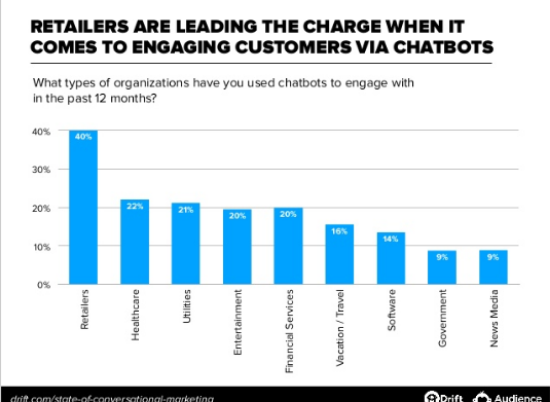
Source: Drift
But companies in all industries are already winning big with their conversational marketing strategies. Here are 10 of the best examples we've seen:
Spring
Spring developed a personalized shopper bot that sorts out exactly what styles you’re actually in to after asking a few questions to help it along.
You can narrow down the type of product and price range you’re looking for, and just like that, Spring will offer you an array of recommendations from across the internet.
The bot helps cut down the time you’d have to spend searching through a massive online catalog by telling Spring exactly what you want.
Lyft
No one has disputed the convenience of ride-sharing apps, but Lyft has taken it to another level with their responsive chatbot.
Now integrated with Messenger, Slack, and Amazon Echo, all you need to do to request a ride is click the car icon. You’ll be instantly matched with drivers in your area.
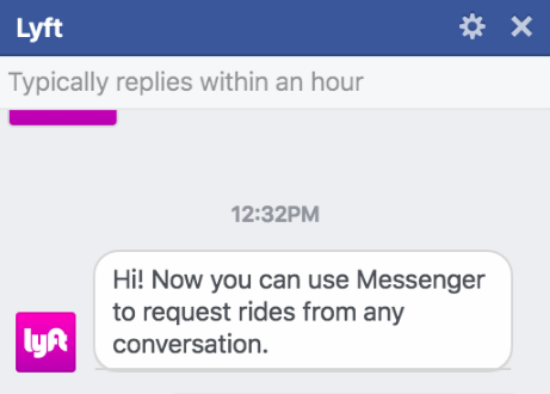
Source: C3 Metrics
Facebook Messenger provides all the necessary information to identify your ride within the chat.
Even Slack bots will order a ride and provide trip information after you search some Lyft-related keywords to use by typing "/lyft" into a channel.
Lyft has worked to make the process of getting to where you need to go easier and faster for customers, all with the help of conversational marketing tools.
Sephora
Beauty and personal care has never been easier. All you need to have is a Facebook account, and you can be in a chair, getting your makeup done in minutes.
Sephora uses a Facebook Messenger that allows you to book appointments automatically with a beauty consultant.
The bot can use geolocation tracking to help customers find the closest stores, driving foot traffic and increasing sales.
HealthTap
HealthTap’s mission is to make healthcare more accessible for people, so they’ve implemented a way to do just that.
A HealthTap chatbot installation is available on Facebook Messenger at all times. The bot will answer almost any health-related question you ask it, showing what doctors have to say about the subject in more detail.
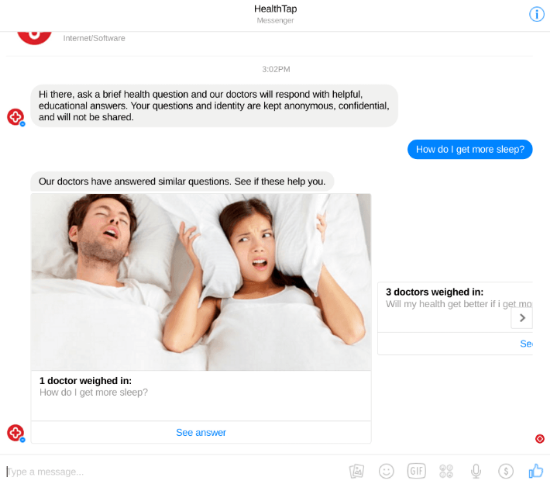
Source: Impact
If you feel like you need more information, though, you can have your question submitted to a real doctor, who will get back to you within 24 hours.
Need answers faster? The bot will guide you to HealthTap’s consulting service, where you can speak with a doctor sooner for $25.
We’d say that HealthTap is well on its way to achieving its goal.
Domino’s
Domino’s had an entire marketing campaign showcasing their new messaging feature.
All you need to do to have your favorite pizza delivered to you is send either a tweet or text a pizza emoji to a contact number.
Granted, you’ll have to have a favorite pizza saved on your Domino’s account, but the trick is still considerably faster than having to call the order in.
HelloFresh
Probably the most popular meal kit delivery company, HelloFresh launched Freddy Freshbot as a means to further support users.
Interacting through Facebook Messenger, Freddy can guide you through service offerings, offer recipes, help with meal prep, and even act as a sous chef by setting reminders for you.
The new addition to the service has proven successful for HelloFresh, who already boasted a great user experience.
eBay
eBay’s chatbot has been acknowledged as one of the most advanced on the web. Paired with Google Assistant, the bot can narrow down your product search on the website by voice through Google.
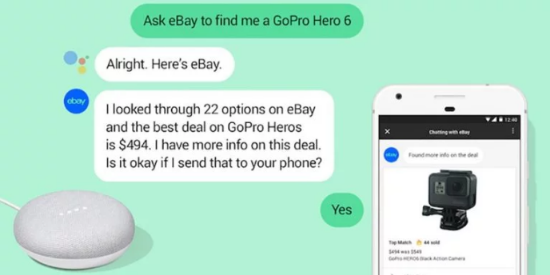
Source: Impact
Next thing you know, you’re bidding and buying online. Pretty successfully too, since the chatbot hunts for the best deals for you.
The user experience feels incredibly personalized also. Giving commands with your own voice makes it feel truly conversational.
1-800-Flowers
1-800-Flowers was one of the first organizations to use chatbots and Facebook Messenger together.
The bot immediately provides relevant floral options once the conversation is started. It guides the user through selecting an arrangement, providing the desired delivery address, and then paying.
The company has reported that 70 percent of orders coming from new customers come from their chatbot.
Databox
Databox makes a point to let leads know they have someone to help them by building an entire sidebar on their homepage for their chatbot.
Relationships start building immediately and leads are qualified at a faster rate because of the feature. Conversations are structured right from the start, allowing users to select a pre-written question or enter one of their own.
KLM
Blue Bot, KLM’s chatbot, lives on Facebook Messenger as a sort of travel assistant.
Fondly known as BB, the bot can plan and book trips for you, then keep you updated on all of your flight information. BB even provides packing tip videos to help you be as ready as possible for your venture.
BB keeps KLM relevant and connected to their customers by lessening the headache of travel.
5 Conversational Marketing Books and Resources
New to conversational marketing? Or are you just brushing up on the basics? Perhaps you want to take a deep dive into advanced knowledge.
No matter where you are in your conversational marketing journey, you can always benefit from some educational resources.
Online Courses
Drift Insider
Drift’s new content subscription offers a variety of classes, interviews, and courses with expert-level conversational marketing and sales education.
There’s year long access available to all content and forums. Check out their videos that range from copywriting 101 to conversational marketing examples.
Price:
The subscription is completely free.
Fundamentals of Conversational Growth Strategy
HubSpot Academy’s course provides four lessons on why and how conversational marketing tools can help you grow your business.
By the end of the course, you’ll be able to create and launch your own strategy with a thorough understanding of the inbound approach to the process.
Price:
The course is free.
Books
Conversational Marketing: How the World's Fastest Growing Companies Use Chatbots to Generate Leads 24/7/365 (and How You Can Too)
Authors: David Cancel and Dave Gerhardt
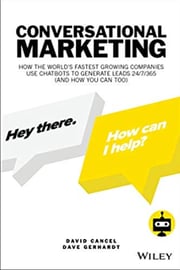
Source: Amazon
A comprehensive guide to generating leads and closing sales, this book explains how to combine inbound and outbound techniques into a more productive interaction with customers.
Cancel and Gerhardt encourage sales teams to integrate the conversational marketing methodology into their marketing techniques so that priorities can be refocused on real-time, one-on-one conversations with customers through messaging and chats.
Conversation Marketing: How to Be Relevant and Engage Your Customer by Speaking Human
Author: Kevin Lund
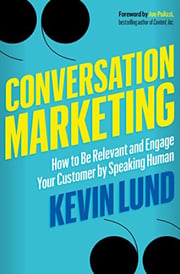
Source: Amazon
Lund expands upon the difference between listening and selling in this valuable resource.
Using conversation marketing to connect your brands to customers on a much deeper level than traditional marketing techniques can only mean success for your business.
He teaches how having a conversation can help you earn your audience’s attention and trust, which will turn them into loyal customers.
The Conversational Marketing Blueprint
Author: Drift Press
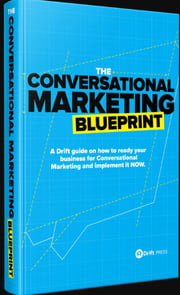
Source: Drift
Drift produced a definitive step-by-step guide to conversational marketing and how to implement it into your existing strategies.
As a leading company in the methodology, they provide incredible insights into how to build your blueprint, case studies, and measuring the ROI of your strategy. A true must have.
With some great examples to draw inspiration from and a few resources to reference, you’re ready to start finding windows in your marketing strategy to implement conversational marketing.
Be strategic and remember, this is all about building a human experience for your audience.


Micah Lally
I’m a Content Writer at Bluleadz. I’m a big fan of books, movies, music, video games, and the ocean. It sounds impossible to do all of those at the same time, but you’d be surprised by the things I can accomplish.